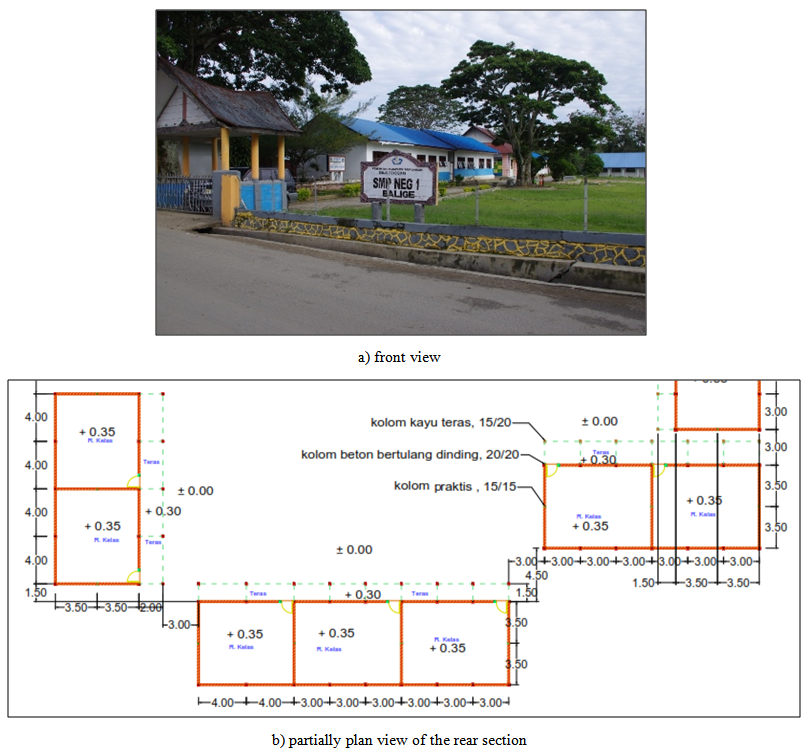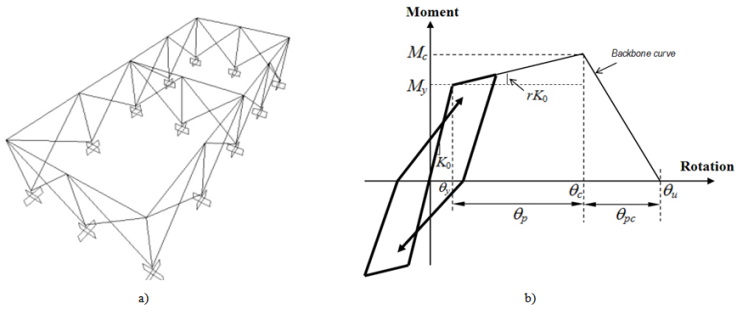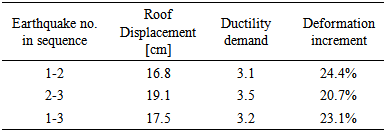-
Paper Information
- Next Paper
- Previous Paper
- Paper Submission
-
Journal Information
- About This Journal
- Editorial Board
- Current Issue
- Archive
- Author Guidelines
- Contact Us
Journal of Civil Engineering Research
p-ISSN: 2163-2316 e-ISSN: 2163-2340
2014; 4(3A): 173-177
doi:10.5923/c.jce.201402.30
Effect of Repeated Earthquakes on the School Building in Northern Sumatra
Ade Faisal, Tondi Amirsyah Putera
Program Studi Teknik Sipil, Universitas Muhammadiyah Sumatera Utara (UMSU), Medan, Indonesia
Correspondence to: Ade Faisal, Program Studi Teknik Sipil, Universitas Muhammadiyah Sumatera Utara (UMSU), Medan, Indonesia.
| Email: |  |
Copyright © 2014 Scientific & Academic Publishing. All Rights Reserved.
The earthquakes struck a region near the active fault for many times. The yielded structures after an earthquake might become excessive damages after experiencing another earthquake. The concept of seismic design of building has not consider this type of hazard. Recent studies indicate that the effect of repeated earthquake is significantly occurred on the moment resisting bare frames, either made from steel or concrete material. This paper investigates the effect of repeated earthquake on the frames with infilled brick wall. The frames represent school building built on the regions near the Sumatran active fault, Indonesia. The result shows that the sequence of plastic hinges occur on the structures model after experiencing the repeated earthquake. It starts from the brick wall and then spreads to the columns and beams. For the single earthquakes, the brick wall of structures model tends to perform damage, but few of columns and beams experiences hinges. These conclude that the future repeated earthquake can not be underestimated.
Keywords: Nonlinear inelastic analysis, School building, Repeated earthquakes, Sumatra
Cite this paper: Ade Faisal, Tondi Amirsyah Putera, Effect of Repeated Earthquakes on the School Building in Northern Sumatra, Journal of Civil Engineering Research, Vol. 4 No. 3A, 2014, pp. 173-177. doi: 10.5923/c.jce.201402.30.
Article Outline
1. Introduction
- There are few studies have examined the effect of seismic repetitions on the buildings. Elnashai et al. [1] has predicted that the multiple earthquake ground motions can give ductility demand required significantly higher than that required by a single event. Continuous reduction in the lateral stiffness was also detected on a building built on soft soil having several low magnitude earthquake ground motions [2]. Amadio et al. [3] indicates that repeated earthquakes can imply a considerable accumulation of damage and a consequent reduction in the force reduction factor. Hatzigeorgiou and Beskos [4] runs million nonlinear time history analyses on the elasto-plastic SDOF system with strain hardening and empirically introduced an expression to estimate the inelastic displacement ratio (defined as the ratio of maximum inelastic displacement and maximum elastic displacement) on the flexural-based RC and steel structures based on period of vibration, force reduction factor, site conditions, post-yield stiffness, and damping. It concludes that repeated earthquakes require increased displacement demands in comparison with single seismic events as in design earthquake. They find the inelastic displacement ratio for all SDOF systems built at all soil types generally appear to be increased 2 times or more with respect to that obtained for the corresponding single earthquakes.Faisal et al. [5] have studied three-dimensional moment resisting frame under bi-directional seismic excitation. It explains that the story ductility demand of low-story reinforced concrete buildings are significantly affected by repeated earthquakes. It finds that as the force reduction factor decreases the effect of repeated earthquake is decreases. The effect could be neglected when the structures have force reduction factor of less than two. The upper level of the short structure tends to have the maximum demand when experiencing repeated earthquakes.The aforementioned studies explore the bare moment resisting frame in two-dimensional and three-dimensional structural model under repeated earthquakes. Actually, most of reinforced concrete frame buildings have the infilled-wall in order to separating the space. Therefore this paper discusses the effect of repeated earthquakes on the single story buildings having infilled brick wall. The school buildings in the surrounding Sumatran fault are selected to be the model of single story buildings. This study observes the plastic hinge on the school building structures under the sequence of seismic motion.
2. Methodology
2.1. School Building Survey
- The study surveys 8 school buildings situated in the cities near the Sumatran active fault. Table 1 shows the surveyed buildings, which are placed in 6 cities. All of the surveyed buildings are single story reinforced concrete (RC) buildings, which are consist of old and new buildings. Fig. 1 shows the example of surveyed building in Balige, which is the junior high school managed by the local government. Mostly, the old building is arranged in one block, whereas the other blocks are the new buildings. For the sake of simplicity in the modelling of structure, the term new in this case is represent the buildings that were built after the year of 2000. It is meant that the study assumed the surveyed buildings were designed in accordance with the building code released within this years.
 | Table 1. The school buildings considered in this study |
 | Figure 1. The junior high school in Balige |
2.2. Modeling of the School Building Structures
- The junior high school building in Balige is used as an example in this study. The building has 2 class rooms with geometry dimension 8 x 7 m of each, as shown in Fig. 1a. This school building structures are modeled as the 3-dimensional moment resisting frames with infilled brick wall. The infilled brick wall is modeled as the strut-tie element or compressional member (Fig. 2a). The strength of infilled brick wall is assumed to be 3,54 MPa and its elastic moduli is 1000 MPa. The thickness of brick wall is assumed to be 10 cm. These values are based on the test done by Aryanto [6]. Therefore the equivalent depth and the ultimate normal strength of brick wall are found to be 0,79 m and 470 kN, respectively. For the infilled brick wall with opening, this study uses the reduction factor to introduce to the ultimate strength of the brick wall.
2.3. Modeling of the Repeated Earthquakes Ground Motions
- The ground motion record is taken from PEER—NGA database and all motions are near fault motion type, as listed in Table 2 and shown in Fig. 3. It is not possible to find the identical seismological parameter as in Sumatran fault earthquake in searching the ground motion record in the database. Therefore, the selection is made only based on the shallow crustal earthquakes on the stiff soil. These selected ground motions are scaled to the design spectra in Indonesian Seismic Code (SNI 1726:2012) [11] based on its response spectrum at the building’s fundamental period.
 | Table 2. List of earthquake ground motions used in this study |
 | Figure 3. Near-fault ground motion model: a) major and minor components, b) double events motion model |
3. Result and Discussion
- The model of school building has fundamental period of 0.12 s and 0.11 s for strong and weak directions, respectively. This short period is typical for short structures and would be sensitive to the high frequency ground motion (e.g. near fault ground motion). The result of linear analysis indicates that the school building structures without infilled wall have a poor lateral strength. This strength is significantly increased when the infilled is taking into account in the analysis. The pushover analysis indicates that the yield deformation of school building model achieves 5.4 cm. The result of nonlinear inelastic response history analysis in form of displacement is listed in Table 3 and 4. These tables explain that the lateral deformation demand significantly increases of up to 24,4% due to repeated earthquakes (double event). It means that the cracked element after a single event of earthquake could be excessively damaged when experiencing the double event of earthquakes.
|
|
4. Conclusions
- This study investigates the deformation and damage of the single story school building near the Sumatran fault under the repeated ground motions. The result concludes that the repeated earthquake can increase the ductility demand of the school building built on the stiff soil of up to 24.4%. The damage after the repeated ground motion is found to be significantly increased in comparison with the damage due to single event of earthquakes. All of the infilled brick wall and the beam element are found to be totally damage after experiencing the repeated ground motions. Plastic hinges are exhibited in the most of column due to the double event of earthquakes, whereas only few of columns are experienced it when the single event of earthquake occurred. In order to avoid any casualties, the repeated earthquake shall be considered in Indonesian seismic code.
ACKNOWLEDGEMENTS
- This research is fully funded by Directorate General of Higher Education, Ministry of Education and Culture, through the Penelitian Desentralisasi Hibah Bersaing under the contract with no. 70/II.3-AU/UMSU-P3M/C/2014. This support is much appreciated.
 Abstract
Abstract Reference
Reference Full-Text PDF
Full-Text PDF Full-text HTML
Full-text HTML

